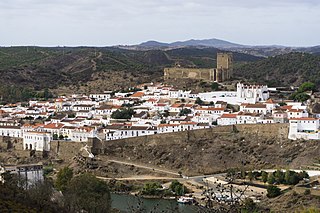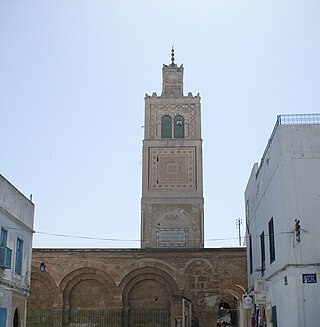
The Mosque–Cathedral of Córdoba, officially known by its ecclesiastical name of Cathedral of Our Lady of the Assumption, is the cathedral of the Diocese of Córdoba dedicated to the Assumption of Mary and located in the Spanish region of Andalusia. Due to its status as a former mosque, it is also known as the Mezquita and as the Great Mosque of Córdoba.

Mértola is a town and municipality in southeastern Portuguese Alentejo near the Spanish border. In 2011, the population was 7,274, in an area of approximately 1,292.87 square kilometres (499.18 sq mi): it is the sixth-largest municipality in Portugal. Meanwhile, it is the second-lowest population centre by density with approximately 5.62 persons/1 square kilometre (0.39 sq mi).

The Mosque of Ibn Tulun is located in Cairo, Egypt. It is one of the oldest mosques in Egypt as well as the whole of Africa surviving in its full original form, and is the largest mosque in Cairo in terms of land area. It is built around an open square courtyard which allows natural light to travel through. Ibn Tulun Mosque features ancient architecture styles of Egypt, its decorations being created from carved stucco and wood. This mosque is a popular tourist attraction.

Hassan Tower or Tour Hassan (Arabic: صومعة حسان; is the minaret of an incomplete mosque in Rabat, Morocco. It was commissioned by Abu Yusuf Yaqub al-Mansur, the third caliph of the Almohad Caliphate, near the end of the 12th century. The tower was intended to be the largest minaret in the world, and the mosque, if completed, would have been the largest in the western Muslim world. When al-Mansur died in 1199, construction on the mosque stopped. The minaret was left standing at a height of 44 meters. The rest of the mosque was also left incomplete, with only the beginnings of several walls and 348 columns being constructed. The tower, along with the remains of the mosque and the modern Mausoleum of Mohammed V, forms an important historical and tourist complex in Rabat.

Arrifana is a small parish and fishing village in the Faro District's Aljezur Municipality in the Barlavento Algarvio region of Portugal. It is situated near the border between the Aljezur and Alentejo regions on the coast of the Atlantic Ocean and is within the Costa Vicentina park. Arrifana is located about 6 km from Aljezur.

Moorish architecture is a style within Islamic architecture which developed in the western Islamic world, including al-Andalus and what is now Morocco, Algeria, and Tunisia. Scholarly references on Islamic architecture often refer to this architectural tradition in terms such as architecture of the Islamic West or architecture of the Western Islamic lands. The use of the term "Moorish" comes from the historical Western European designation of the Muslim inhabitants of these regions as "Moors". Some references on Islamic art and architecture consider this term to be outdated or contested.

The Mosque of Cristo de la Luz is a Catholic chapel and former mosque in Toledo, Spain. It is the one of the ten that existed in the city during the Moorish period. The edifice was then known as Mezquita Bab-al-Mardum, deriving its name from the city gate Bab al-Mardum. It is located near the Puerta del Sol, in an area of the city once called Medina where wealthy Muslims used to live.

The Great Mosque of Tlemcen is a major historic mosque in Tlemcen, Algeria. It was founded and first built in 1082 but modified and embellished several times afterwards. It is considered one of the most important examples of architecture under the Almoravid dynasty.

The Kasbah of the Udayas, also spelled Kasbah of the Oudaias or of the Oudayas, is a kasbah (citadel) in Rabat, Morocco. It is located on a hill at the mouth of the Bou Regreg opposite Salé, and adjacent to the Medina quarter of Rabat. It is listed, along with other sites in Rabat, as a UNESCO World Heritage Site.

The horseshoe arch, also called the Moorish arch and the keyhole arch, is a type of arch in which the circular curve is continued below the horizontal line of its diameter, so that the opening at the bottom of the arch is narrower than the arch's full span. Evidence for the earliest uses of this form are found in Late Antique and Sasanian architecture, but it became emblematic of Islamic architecture, especially Moorish architecture. It also made later appearances in Moorish Revival and Art Nouveau styles. Horseshoe arches can take rounded, pointed or lobed form.

Ksar Mosque or Jemaâ Al Ksar, also of the Hanafi rite, is a mosque in Tunis, Tunisia.

Almohad architecture corresponds to a period from the 12th to early 13th centuries when the Almohads ruled over the western Maghreb and al-Andalus. It was an important phase in the consolidation of a regional Moorish architecture shared across these territories, continuing some of the trends of the preceding Almoravid period and of Almoravid architecture.

The Great Mosque of Sousse is a historical mosque in the coastal city of Sousse, Tunisia. The construction dates back to 851, during the rule of the Aghlabid dynasty, vassals of the Abbasid Caliphate. It was commissioned by the ruler Abu al-‘Abbas Muhammad al-Aghlabi. It is a major monument of Aghlabid architecture in the early Islamic period. The mosque was renovated and its prayer hall expanded multiple times over the following centuries.

São Clemente is a Portuguese civil parish (freguesia) in the municipality of Loulé.

The Kasbah Mosque is a historic mosque in Marrakesh, Morocco. It was originally built by the Almohad ruler Yaqub al-Mansur in 1185-1190 CE. It is located in the Kasbah district, the city's former citadel, near the site of its historic royal palaces. Along with the Kutubiyya Mosque, it is one of the most important historic mosques in Marrakesh.

The Ribat of Arrifana is the archeological site of the remains of a Muslim fortification (ribat) situated in Arrifana, Aljezur municipality, in the Faro District of the Algarve region, Portugal. It was a Muslim coastal fortress built around 1130 and is the only such Muslim fortress to have been identified in Portugal, having been excavated by Portuguese archaeologists since 2001.
The conversion of mosques into non-Islamic places of worship has occurred for centuries. The most prominent examples of such took place after and during the Reconquista.

The architecture of Tunisia began with the ancient civilizations such as the Carthaginians, Numidians, and Romans. After the 7th century, Islamic architecture developed in the region under a succession of dynasties and empires. In the late 19th century French colonial rule introduced European architecture, and modern architecture became common in the second half of the 20th century. The southern regions of the country are also home to diverse examples of local vernacular architecture used by the Berber (Amazigh) population.

Aghlabid architecture dates to the rule of the Aghlabid dynasty in Ifriqiya during the 9th century and the beginning of the 10th century. The dynasty ruled nominally on behalf of the Abbasid Caliphs, with which they shared many political and cultural connections. Their architecture was heavily influenced by older antique architecture in the region as well as by contemporary Abbasid architecture in the east. The Aghlabid period is also distinguished by a relatively large number of monuments that have survived to the present day, a situation unusual for early Islamic architecture. One of the most important monuments of this period, the Great Mosque of Kairouan, was a model for mosque architecture in the region. It features one of the oldest minarets and contains one of the oldest surviving mihrabs in Islamic architecture.























